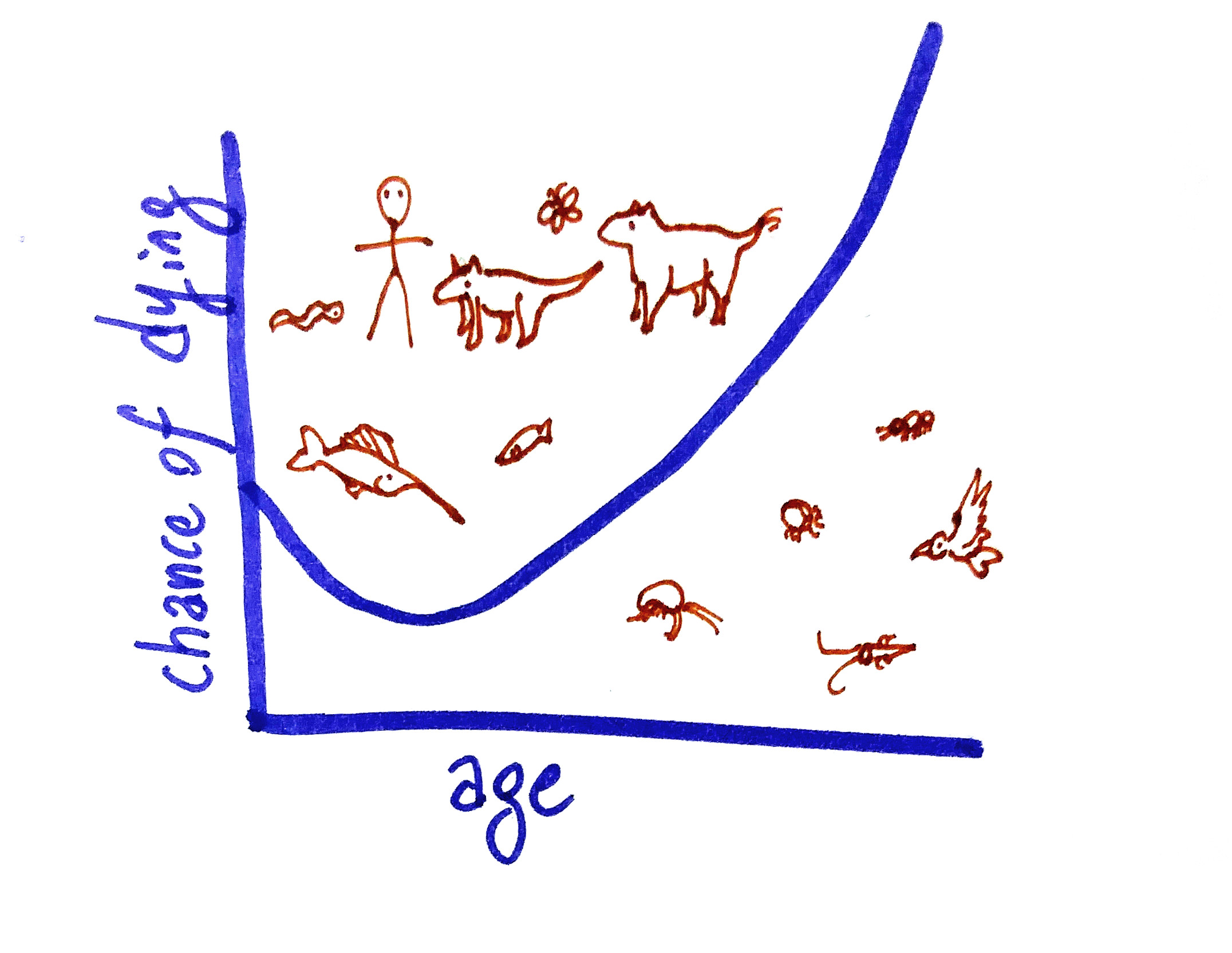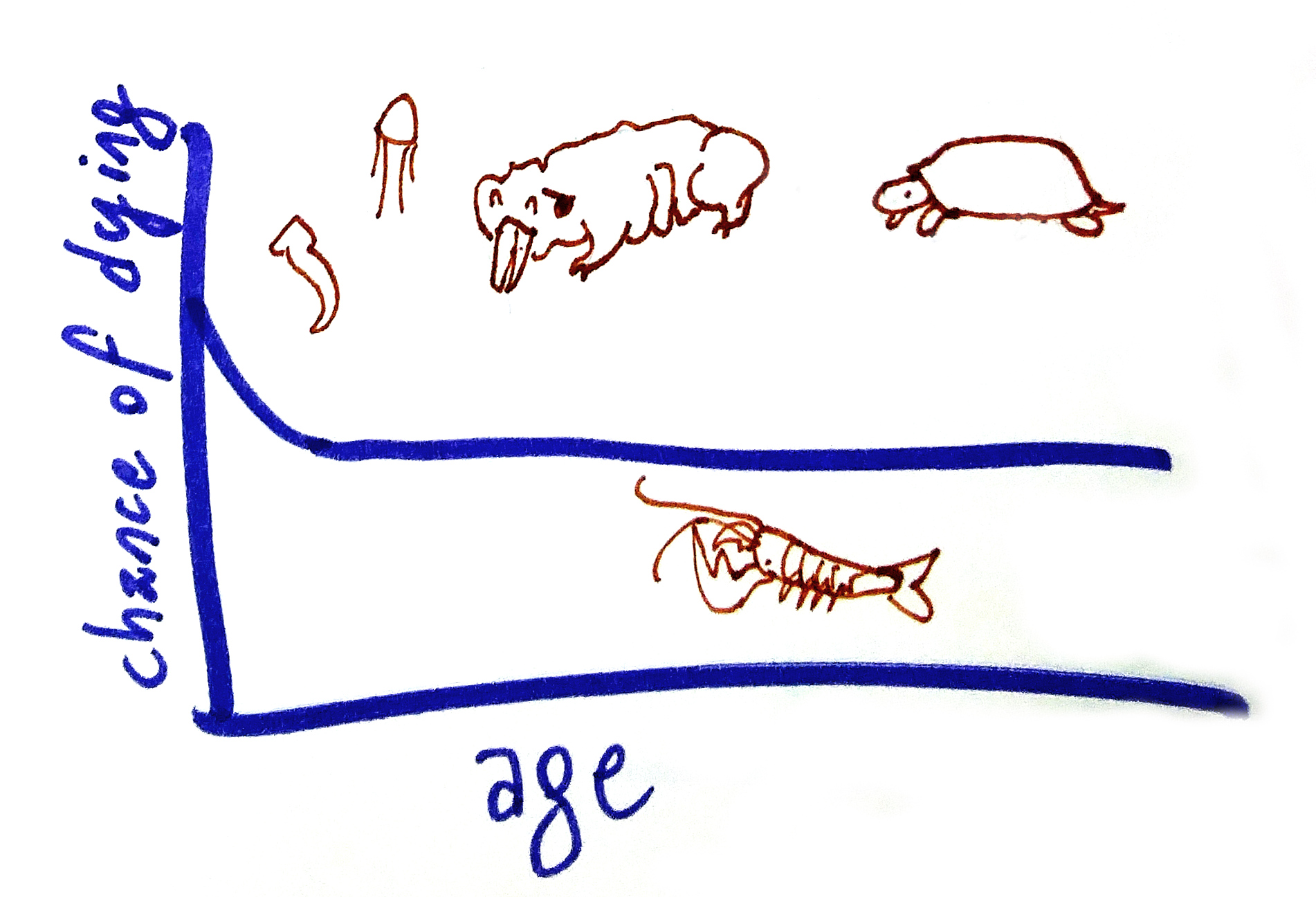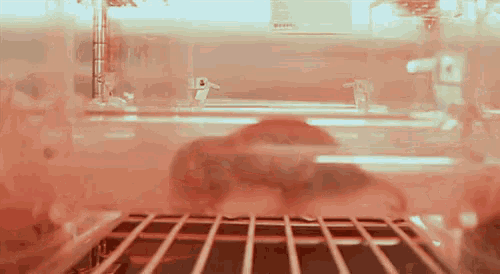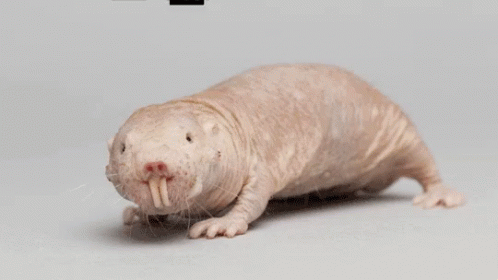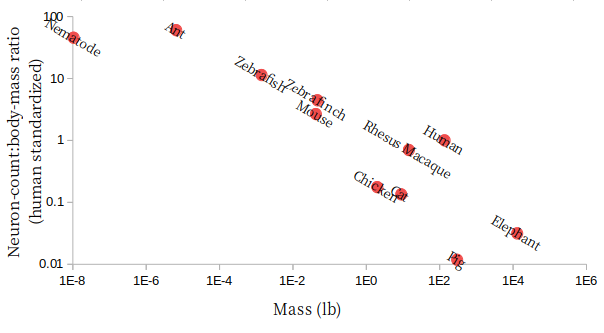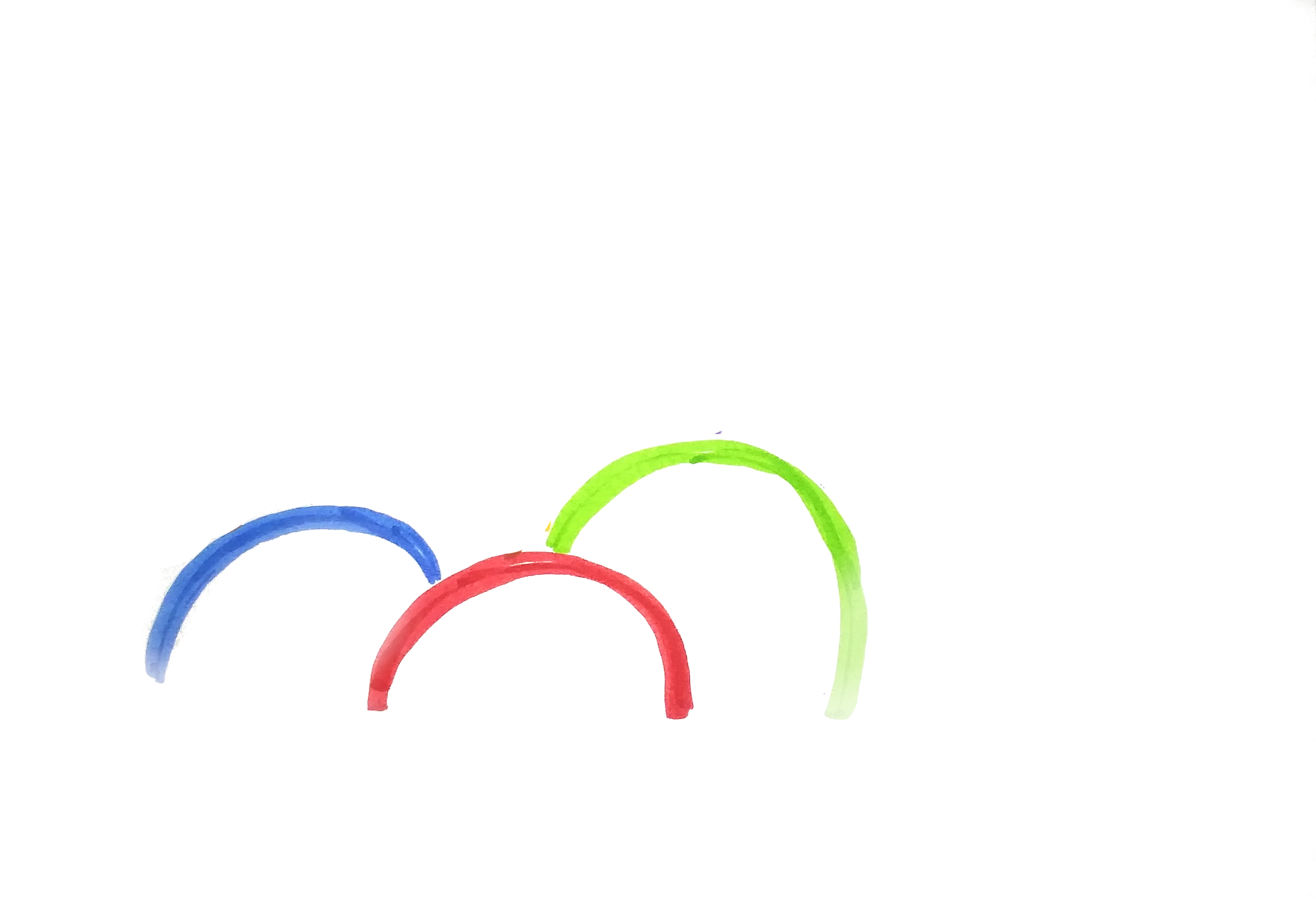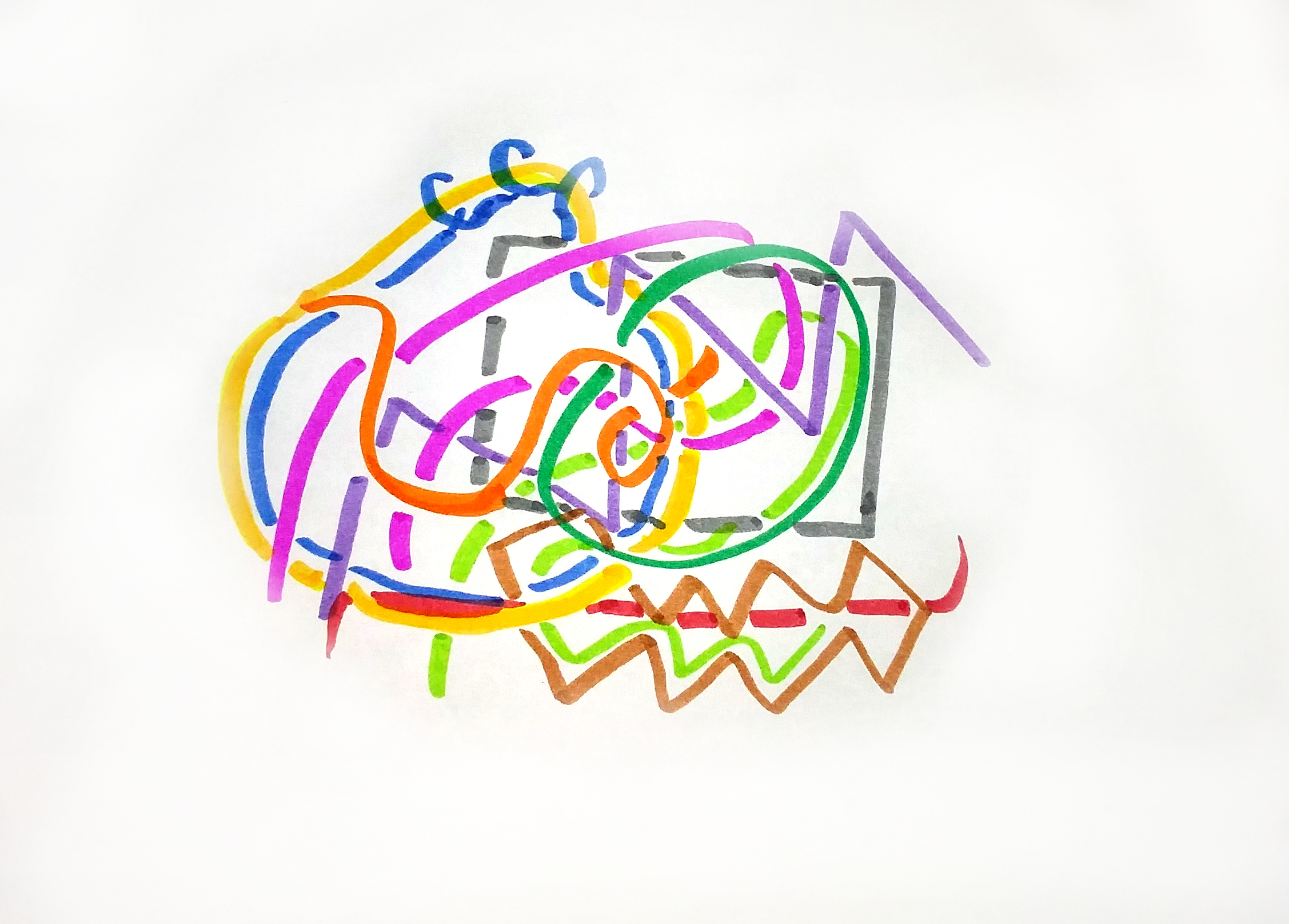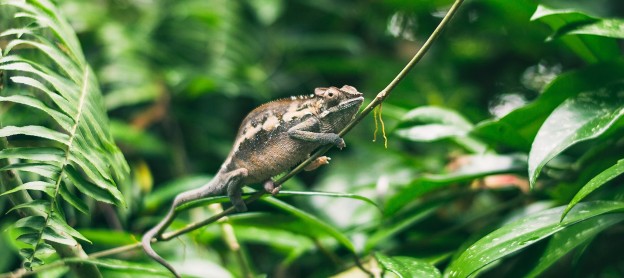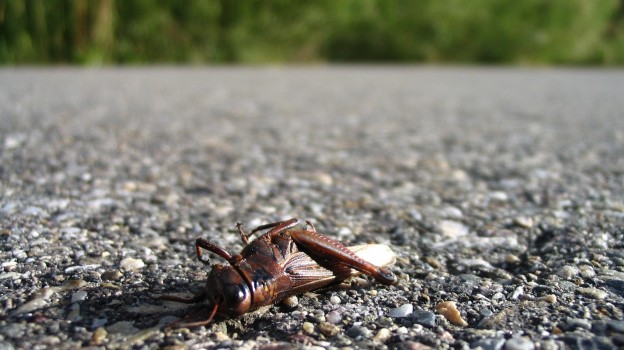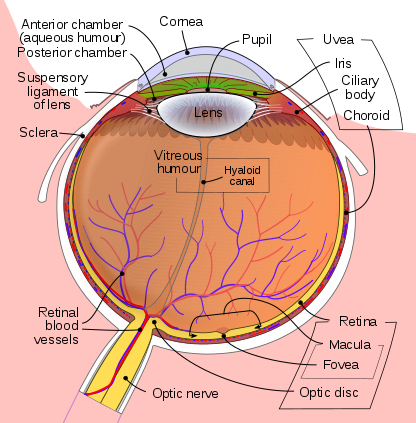Helpful background reading: What’s the deal with prions?
A novel lethal infectious neurological disease emerged in American deer a few decades ago. Since then, it’s spread rapidly across the continent. In areas where the disease is found, it can be very common in the deer there.
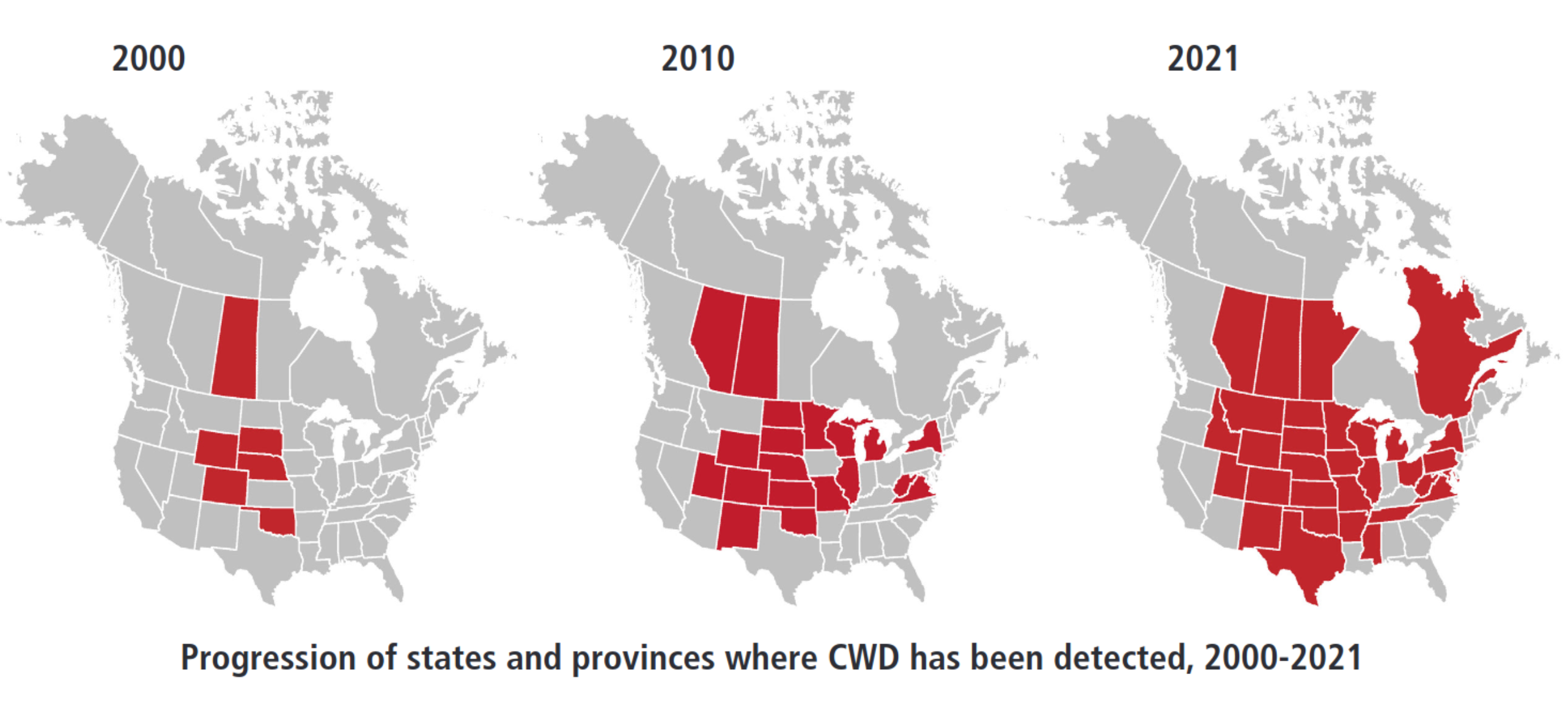
Chronic wasting disease isn’t caused by a bacteria, virus, protist, or worm – it’s a prion, which is a little misshapen version of a protein that occurs naturally in the nervous systems of deer.
Chemically, the prion is made of exactly the same stuff as its regular counterpart – it’s a string of the same amino acids in the same order, just shaped a little differently. Both the prion and its regular version (PrP) are monomers, single units that naturally stack on top of each other or very similar proteins. The prion’s trick is that as other PrP moves to stack atop it, the prion reshapes them – just a little – so that they also become prions. These chains of prions are quite stable, and, over time, they form long, persistent clusters in the tissue of their victims.
We know of only a few prion diseases in humans. They’re caused by random chance misfolds, a genetic predisposition for PrP to misfold into a prion, accidental cross-contamination via medical supplies, or, rarely, from the consumption of prion-infected meat. Every known animal prions is a misfold of the same specific protein, PrP. PrP is expressed in the nervous system, particularly in the brain – so infections cause neurological symptoms and physical changes to the structure of the brain. Prion diseases are slow to develop (up to decades), incurable, and always fatal.
There are two known infectious prion diseases in people. One is kuru, which caused an epidemic among tribes who practiced funerary cannibalism in Papua New Guinea. The other is mad cow disease, also known as bovine spongiform encephalopathy (BSE) AKA Variant Creutzfeldt-Jakob disease, which was first seen in humans in 1996 in the UK, and comes from cows.
Chronic wasting disease (CWD)…
- Is, like every other animal prion disease, a misfold of PrP. PrP is quite similar in both humans and deer.
- Is found in multiple deer species which are commonly eaten by humans.
- Can be carried in deer asymptomatically.
But it doesn’t seem to infect people. Is it ever going to? If a newly-emerged virus were sweeping across the US and killing deer, which could be spread through consuming infected meat, I would think “oh NO.” I’d need to see very good evidence to stop sounding the alarm.
Now, the fact that it’s been a few decades, and it hasn’t spread to humans yet, is definitely some kind of evidence about safety. But are we humans basically safe from it, or are we living on borrowed time? If you live in an area where CWD has been detected, should you eat the deer?
Sidenote: Usually, you’ll see “BSE” used for the disease in cows and “VCJ” for the disease in humans. But they’re caused by the same agent and this essay is operating under a zoonotic One Health kind of stance, so I’m just calling the disease BSE here. (As well as the prion that causes it, when I can get away with it.)
In short
The current version of CWD is not infectious to people. We checked. BSE showed that prions can spill over, and there’s no reason a new CWD variant will never do the same. The more cases there are, the more likely it is to spill over. That said, BSE did not spill over very effectively. It was always incredibly rare in humans. It’s an awful disease to get, but the chance of getting it is tiny. Prions in general have a harder time spilling over between species than viruses do. CWD might behave somewhat differently but probably will stay hampered by the species barrier.
Why do I think all of this? Keep reading.
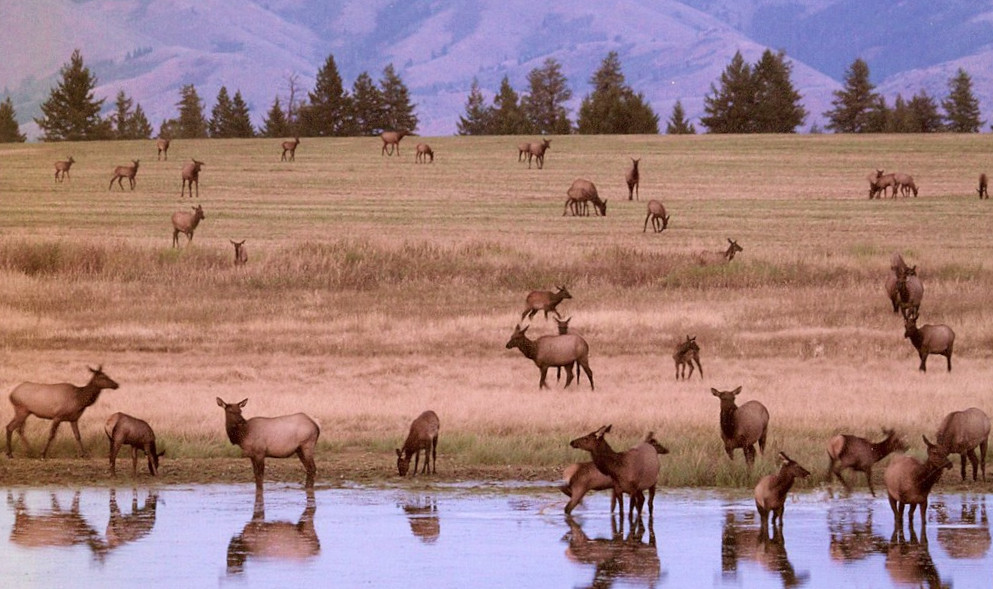
Prions aren’t viruses
I said before that if a fatal neurological virus were infecting deer across the US, and showed up in cooked infected meat, my default assumption would be “we’re in danger.” But a prion isn’t a virus. Why does that matter?
Let’s look at how they replicate. A virus is a little bit of genetic material in a protein coating. You, a human, are a lot of genetic in a protein coating. When a virus replicates, it slips into your cells, and it hijacks your replication machinery to run its genes instead. Instead of all the useful-to-you tasks your genome has planned, the virus’s genome outlines its own replication, assembles a bunch more viruses, and blows up the factory (cell) to turn them loose into the world.
In other words, the virus using a robust information-handling system that both you and it have in common – the DNA → RNA → protein pipeline often called “the central dogma” of biology. To a first approximation, you can just add any genetic information at all into the viral genome, and as long as it doesn’t interfere with the virus’s process, whatever you add will get replicated in there too.
Prions do not work like this. They don’t tap into the central dogma. What makes them so fundamentally cool is that they replicate without touching the replication machinery that everything else alive uses – their replication is structural, like a snowflake forming. The host provides raw material in the form of PrP, and the prion – once it lands – encourages that material to shape in the right way for more to form atop it.
What this means is that you can’t encode arbitrary information into a prion. This isn’t just a factor – it’s not as though a prion runs on a separate “protein genome” we could decipher and then encode what we like into. The entire structure of the prion has to work together to replicate itself. If you made a prion with some different fold in it, that fold has to not just form a stable protein, but to pass itself along as well. They don’t have a handy DNA replicase enzyme to outsource to – they have to solve the problem of replication themselves, every time.
Prions can evolve, but they do it less – they have fewer free options, they’re more constrained than a virus would be in terms of changes that don’t interrupt the rest of the refolding process and that on top of that promulgate themselves.
This means that prions are slower to evolve than viruses. …I’m pretty sure, at least. It makes a lot of sense to me. The thing that this definitely means is that:
It’s very hard for prions to cross species barriers
PrP is a very conserved protein across mammals, meaning that all mammals have a version of PrP that’s pretty similar – 90%+ similarity.* But the devil lies in that 10%.
Prions are finely tuned – to convert PrP to a prion, it basically needs to be identical, or at least functionally identical, everywhere the prion works. It not just needs to be susceptible to the prion’s misfolding, it also needs to fold into something that itself can replicate. A few amino acid differences can throw a wrench in the works.
It’s clear that infectious prions can have a hard time crossing species barriers. It depends on the strain. For instance: Mouse prions convert hamster PrP.** Hamster prions don’t convert mouse PrP. Usually a prion strain converts its usual host PrP best, but one cat prion more efficiently converts cow PrP. In a test tube, CWD can convert human or cow PrP a little, but shows slightly more action with sheep PrP (and much more with, of course, deer PrP.)
This sounds terribly arbitrary. But remember, prion behavior comes down to shape. Imagine you’re playing with legos and duplo blocks. You can stack legos on legos and duplos on duplos. You can also put a duplo on top of a lego block. But then you can only add duplo blocks on top of that – you’ve permanently changed what can get added to that stack.

When we look at people – or deer, or sheep, etc – who are genetically resistant to prions (more on that later), we find that serious resistance can be conferred by single nucleic acid changes in the PrP gene. Tweak one single letter of DNA in the right place, and their PrP just doesn’t bend into the prion shape easily. If the infection takes, it proceeds slower – slow enough a person might die of old age before the prion would kill them.
So if a decent number of members of a species can be resistant to prion diseases, based on as little as one amino acid – then a new species, one that might have dozens of different amino acids in the PrP gene, is unlikely to be fertile ground for an old prion.
* (This is kind of weird given that we don’t know what PrP actually does – the name PrP just stands “prion protein” because it’s the protein that’s associated with prions, and we don’t know its function. We can genetically alter mice so that they don’t produce PrP at all, and they show slight cognitive issues but they’re basically fine. Classic evolution. It’s appendices all over again.)
** Sidebar: When we look at studies for this, we see that like a lot of pathology research, there's a spectrum of experiments on different points on the axis from “deeply unrealistic” to “a pretty reasonable simulacrum of natural infection”, like: 1. Shaking up loose prions and PrP in a petri dish and seeing if the PrP converts 2. Intracranial injection with brain matter (i.e. grinding up a diseased brain and injecting some of that nasty juice into the brain of a healthy animal and seeing if it gets sick) 3. Feeding (or some other natural route of exposure) a plausible natural dose of prions to a healthy animal and seeing if that animal gets sick The experiments mentioned below are based on 1. Only experiments that do 3 actually prove the disease is naturally infectious. For instance, Alzheimer’s disease is “infectious” if you do 2, but since nobody does that, it’s not actually a contagious threat. That said, doing more-abstracted experiments means you can really zoom in on what makes strain specificity tick.
But prions do cross species barriers
Probably the best counterargument to everything above is that another prion disease, BSE, did cross the species barrier. This prion pulled off a balancing act: it successfully infected cows and humans at the same time.
Let’s be clear about one big and interesting thing: BSE is not good at crossing the species barrier. When I say this, I mean two things:
First, people did not get it often. While the big UK outbreak was famously terrifying, only around 200 people ever got sick from mad cow disease. Around 200,000 cows tested positive for it. But most cows weren’t tested. Researchers estimate that 2 million cows total in the UK had BSE, most of which were slaughtered and entered the food chain. These days, Britain has 2 million cows at any given time.
At first glance, and to a first approximation, I think everyone living in the UK for a while between 1985 and 1996 or so (who ate beef sometimes) must have eaten beef from an infected animal. That’s approximately who the recently-overturned blood donation ban in the US affected. I had thought that was sort of an average over who was at risk of exposure – but no, that basically encompassed everyone who was exposed. Exposure rarely leads to infection.
You’re more likely to get struck by lightning than to get BSE even if you have eaten BSE-infected beef.
Second, in the rare cases the disease takes, it’s slower. Farm cows live short lives, and the cows that died from BSE would have gotten old for the beef industry at 4-5 years post-exposure. They survived at most weeks or months after symptoms began. Humans infected with BSE, meanwhile, can harbor it for up to decades post-exposure, and live an average of over a year after showing symptoms.
I think both of these are directly attributable to the prion just being less efficient at converting human PrP – versus the PrP of the cows it was adapted to. It doesn’t often catch on in the brain. When it does, it moves extremely slowly.
But it did cross over. And as far as I can tell, there’s no reason CWD can’t do the same. Like viruses, CWD has been observed to evolve as it bounces between hosts with different genotypes. Some variants of CWD seem more capable of converting mouse PrP than the common ones. The good old friend of those who play god, serial passaging, encourages it.
(Note also that all of the above differs from kuru, which did cause a proper epidemic. Kuru spread between humans and was adapted for spreading in humans. When looking to CWD, BSE is a better reference point because it spread between cows and only incidentally jumped to humans – it was never adapted for human spread.)
How is CWD different from BSE?
BSE appears in very low, very low numbers anywhere outside the brains and spines of its victims. CWD is also concentrated in the brains, but also appears in the spines and lymphatic tissue, and to a lesser but still-present degree, everywhere else: muscle, antler velvet, feces, blood, saliva. It’s more systematic than BSE.
Cows are concentrated in farms, and so are some deer, but wild deer carry CWD all hither and yon. As they do, they leave it behind in:
- Feces – Infected deer shed prions in their feces. An animal that eats an infected deer might also shed prions in its feces.
- Bodies – Deer aren’t strictly herbivorous if push comes to shove. If a deer dies, another deer might eat the body. One study found that after a population of reindeer started regularly gnawing on each other’s antlers (#JustDeerThings), CWD swept in.
- Dirt – Prions are resilient and can linger, viable, in soil. Deer eat dirt accidentally while eating grass, as well as on purpose from time to time and can be infected.
- Grass – Prions in the soil or otherwise deposited onto plant tissue can hang out in living grass for a long time.
- Ticks – One study found that ticks fed CWD prions don’t degrade the protein. If they’re then eaten by deer (for instance, during grooming), they could spread CWD. This study isn’t perfect evidence; the authors note that they fed the ticks a concentration of prions about 1000x higher than is found in infected deer blood. But if my understanding of statistics and infection dynamics is correct, that suggests that maybe 1 in 1000 ticks feeding on infected deer blood reaches that level of infectivity? Deer have a lot of ticks! Still pretty bad!
That’s a lot of widespread potentially-infectious material.
When CWD is in an area, it can be very common – up to 30% of wild deer, and up to 90% of deer on an infected farm. These deer can carry CWD and have it in their tissues for quite some time asymptomatically – so while it frequently has very visible behavioral and physical symptoms, it also sometimes doesn’t.
In short, there’s a lot of CWD in lots of places through the environment. It’s also spreading very rapidly. If a variant capable of infecting both deer and humans emerged, there would be a lot of chances for possible exposure.

What to do?
As an individual
As with any circumstance at all, COVID or salmonella or just living in a world that is sometimes out to get you, you have to choose what level of risk you’re alright with. At first, writing this piece, I was going to make a suggestion like “definitely avoid eating deer from areas that have CWD just in case your deer is the one that has a human-transmissible prion disease.” I made a little chart about my sense of the relative risk levels, to help put the risk in scale even though it wasn’t quantified. It went like this:
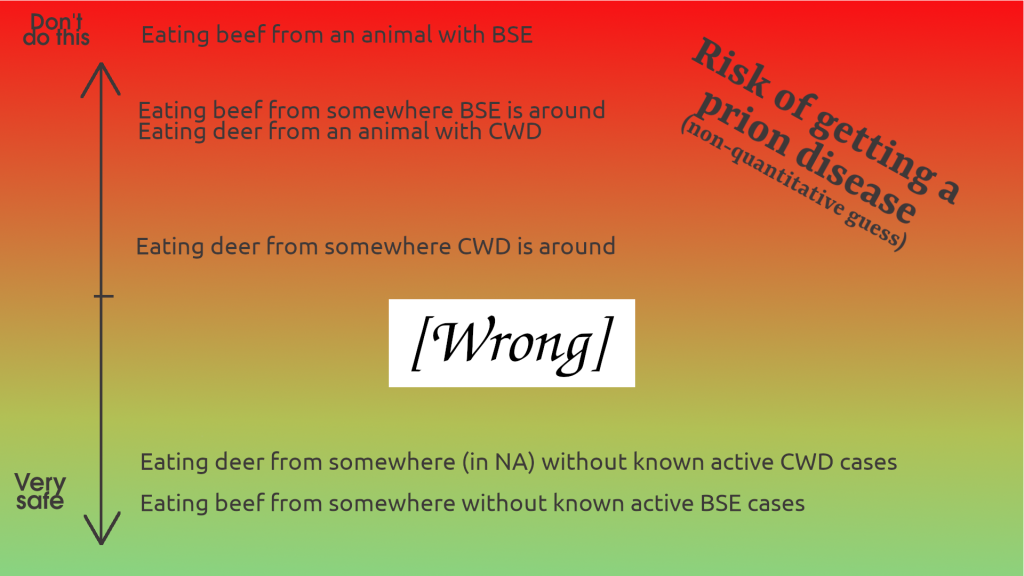
But, as usual, quantification turns out to be pretty important. I actually did the numbers about how many people ever got sick from BSE (~200) and how many BSE-infected cows were in the food chain (~2,000,000), which made the actual risk clear. So I guess the more prosaic version looks like this:
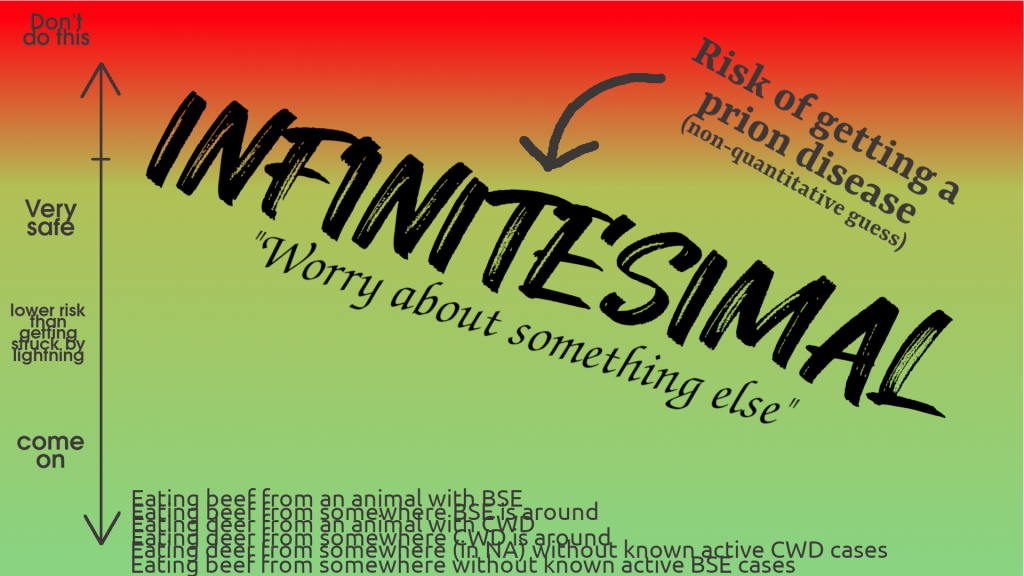
…This is sort of a joke, to be clear. There’s not a health agency anywhere on earth that will advise you to eat meat from cows known to have BSE, and the CDC recommends not eating meat from deer that test positive for CWD (though it’s never infected a human before.)
On top of that, the overall threat is still uncertain because what you’re betting on is “the chance that this animal will have had an as-of-yet undetected CWD variant that can infect humans.” There’s inherently no baseline for that!
We don’t know what CWD would act like if it spilled over. It might be more infectious and dangerous than other infectious prion diseases we’ve seen – remember, with humans, the sample size is 2! So if CWD is in your area and it’s not a hardship to avoid eating deer, you might want to steer clear. …But the odds are in your favor.
As a society
There’s not an obvious solution. The epidemic spreading among deer isn’t caused by a political problem, it’s from nature.
The US is doing a lot right: mainly, it is monitoring and tracking the spread of the disease. It’s spreading the word. (If nothing else, you can keep track of this by subscribing to google alerts for “chronic wasting disease”, and then pretty often you’ll get an email saying things like “CWD found in Florida for the first time” or “CWD found an hour from you for the first time.”) It is encouraging people to submit deer heads for testing, and not to eat meat from deer that test positive. The CDC, APHIS, Fish & Wildlife Service, and more are all aware of the problem and participating in tracking it.
What more could be done? Well, a lot of the things that would help a potential spillover of CWD look like actions that can be taken in advance of any threatening novel disease. There is research being done on prions and how they cause disease, better diagnostics, and possible therapeutics. All of these are important. Prion disease diagnosis and treatment is inherently difficult, and on top of that, has little overlap with most kinds of diagnosis or treatment. It’s also such a rare set of diseases that it’s not terribly well studied. (My understanding is that right now there are various kinds of tests for specific prion diseases – which could be adapted for a new prion disease – that are extremely sensitive although not particularly cheap or widespread.)
I don’t know a lot about the regulatory or surveillance situation vis-a-vis deer farms, or for that matter, much about deer farms at all. I do know that they seem to be associated with outbreaks, and heavy disease prevalence once there is an outbreak. That’s a smart area to an eye on.
If CWD did spill over, what would happens?
It will probably also take time to locate cases and identify the culprit, but given the aforementioned awareness and surveillance of the issue, it ought to take way less time than it took to identify the causative agent of BSE. Officials are already paying attention to deaths that could potentially be CWD-related, like neurodegenerative illnesses that kill young people.
First, everyone gets very nervous about eating venison for a while.
After that, I expect the effects will look a lot like the aftermath of mad cow disease. Mad cow disease, and very likely a hypothetical CWD spillover, would not be transmissible between people in usual ways – coughing, skin contact, fomites, whatever.
It is transmissible via unnatural routes, which is to say, blood transfusions. You might remember how people who’d spent over 6 months in Britain couldn’t donate blood in the US until 2022, a direct response to the BSE outbreak. Yes, the disease was extremely rare, but unless you can quickly and cheaply test incoming blood donations, a donor could donate blood to multiple people. Suppose some of them donate blood down the line. You’d have a chain of infection and a disease with a potentially decades-long incubation period. And remember, the disease is incurable and fatal. So basically, the blood donation system (and probably other organ donation) becomes very problematic.
That said, I don’t think it would break down completely. In the BSE case, lots of people in the UK eat beef from time to time – probably most people. But with a deerborne disease, I would guess that a lot of the US population could confidently declare that they haven’t eaten deer within the past, say, year or so (prior to a detected outbreak.) So I think there’d be panic and perhaps strain on the system but not necessarily a complete breakdown. Again, all of this is predicated on a new prion disease working like known human prion diseases.
Genetic resistance
One final fun fact: People who have a certain allele in the PrP gene – specifically, have the genotype PRNP 129M/V or V/V – are incredibly genetically resistant to known infectious prion diseases. If they do get infected, they survive for much longer.
It’s also not clear that this would hold true for a hypothetical CWD crossover to humans. But it is true for both kuru and BSE. It’s also partly (although not totally) protective against sporadic Creutzfeldt-Jakob disease.
If you’ve gotten a service like 23&me, maybe check out your data and see if you’re resistant to infectious prion diseases. Here’s what you’re looking for:
129M/V or V/V (amino acids), or G/G or A/G (nucleotides) – rs1799990
If you instead have M/M (amino acids) or A/A (nucleotides) at that site, you’re SOL at a higher but still very low overall risk.
Final thoughts
- I think exercises like “if XYZ disease emerges, what will the ramifications and response be” are valuable. They lead to questions like “what problems will seem obvious in retrospect” and “how can we build systems now that will improve outcomes of disasters.” This is an interesting case study and I might revisit it later.
- Has anyone reading this ever been struck by lightning? That’s the go-to comparison for things being rare. But 1 in 15,000 isn’t, like, unthinkably rare. I’m just curious.
- No, seriously, what’s the deal with deer farms? I never think about deer farms much. When I think of venison, I imagine someone wearing camo and carrying a rifle out into a national forest or a buddy’s backyard or something. How many deer are harvest from hunting vs. farms? What about in the US vs. worldwide? Does anyone know? Tell me in the comments.
This essay was crossposted to LessWrong. Also linked at the EA Forums.
If you want to encourage my work, check out my Patreon. Today’s my birthday! I sure would appreciate your support.
Also, this eukaryote is job-hunting. If you have or know of a full-time position for a researcher, analyst, and communicator with a Master’s in Biodefense, let me know:
Eukaryote Writes Blog (at) gmail (dot) com
In the mean time, perhaps you have other desires. You’d like a one-off research project, or there’s a burning question you’d love a well-cited answer to. Maybe you want someone to fact-check or punch up your work. Either way, you’d like to buy a few hours of my time. Well, I have hours, and the getting is good. Hit me up! Let’s chat. 🐟










